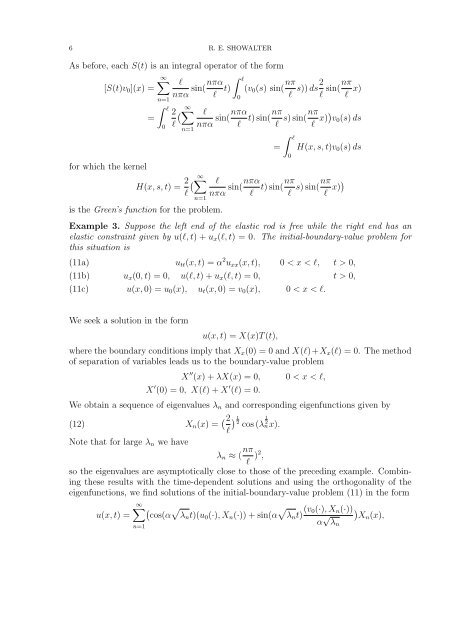THE WAVE EQUATION 1. Longitudinal Vibrations We describe the ...
THE WAVE EQUATION 1. Longitudinal Vibrations We describe the ...
THE WAVE EQUATION 1. Longitudinal Vibrations We describe the ...
Create successful ePaper yourself
Turn your PDF publications into a flip-book with our unique Google optimized e-Paper software.
6 R. E. SHOWALTERAs before, each S(t) is an integral operator of <strong>the</strong> form∞∑∫ll[S(t)v 0 ](x) =nπα sin(nπα lt) (v 0 (s) sin( nπ l s)) ds2 l sin(nπ l x)=n=1∫ l02( ∑∞ln=10lnπα sin(nπα lt) sin(nπ l s) sin(nπ l x)) v 0 (s) dsn=1=∫ l0H(x, s, t)v 0 (s) dsfor which <strong>the</strong> kernelH(x, s, t) = 2 ( ∑∞ ll nπα sin(nπα lt) sin(nπ l s) sin(nπ l x))is <strong>the</strong> Green’s function for <strong>the</strong> problem.Example 3. Suppose <strong>the</strong> left end of <strong>the</strong> elastic rod is free while <strong>the</strong> right end has anelastic constraint given by u(l, t) + u x (l, t) = 0. The initial-boundary-value problem forthis situation is(11a)(11b)(11c)u tt (x, t) = α 2 u xx (x, t), 0 < x < l, t > 0,u x (0, t) = 0, u(l, t) + u x (l, t) = 0, t > 0,u(x, 0) = u 0 (x), u t (x, 0) = v 0 (x), 0 < x < l.<strong>We</strong> seek a solution in <strong>the</strong> formu(x, t) = X(x)T (t),where <strong>the</strong> boundary conditions imply that X x (0) = 0 and X(l)+X x (l) = 0. The methodof separation of variables leads us to <strong>the</strong> boundary-value problemX ′′ (x) + λX(x) = 0, 0 < x < l,X ′ (0) = 0, X(l) + X ′ (l) = 0.<strong>We</strong> obtain a sequence of eigenvalues λ n and corresponding eigenfunctions given byX n (x) = ( 2) 12cos (λ 1 2(12)n x).lNote that for large λ n we haveλ n ≈ ( nπ l )2 ,so <strong>the</strong> eigenvalues are asymptotically close to those of <strong>the</strong> preceding example. Combining<strong>the</strong>se results with <strong>the</strong> time-dependent solutions and using <strong>the</strong> orthogonality of <strong>the</strong>eigenfunctions, we find solutions of <strong>the</strong> initial-boundary-value problem (11) in <strong>the</strong> form∞∑ ( √u(x, t) = cos(α λn t)(u 0 (·), X n (·)) + sin(α √ λ n t) (v 0(·), X n (·))α √ )Xn (x),λ nn=1
















